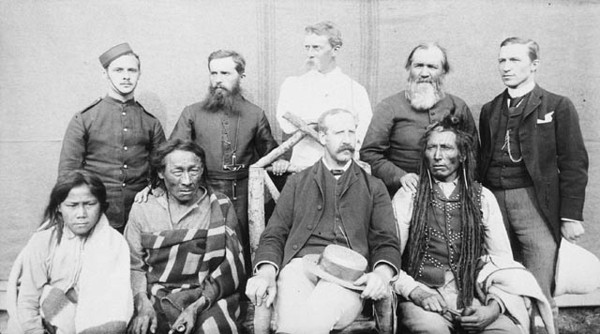

John A. MACDONALD’s approach to the First Nations of Canada was shared by many politicians: they held that Indigenous people should be assimilated first by treaties, and then through property ownership and enfranchisement. Eventually, it was thought, the result would be the end of “Indian status.” An essential step towards this goal was taken in 1876, two years after the Conservatives had lost an election to Alexander MACKENZIE’s Liberals. The Indian Act was the first comprehensive legislation dealing with Indigenous people in the new dominion [see David LAIRD]. The Conservatives returned to power in 1878, and over the next decade and a half they amended the act, but many elements, including funding for residential schools, remained. Ojibwa chief William Bruce M c GREGOR’s biography details the division among Indigenous communities in response to the act:
“McGregor was active on the Grand Council, a predominantly Ojibwa body which met every two years to discuss problems confronting the native people of Ontario. In 1879, for instance, he was one of 85 delegates who met at the Wawanosh (Sarnia) Reserve to discuss the Indian Act of 1876. Many delegates perceived the act, which enfranchised educated people, as a potential means of forcing acculturated Indians off reserves on the grounds that they were no longer band members. McGregor favoured allowing the educated to decide for themselves whether or not to accept enfranchisement. He advocated compulsory school attendance on reserves, arguing that it would enable status Indians to compete in mainstream society. Kegedonce, a fellow delegate, added a demand for better education in the residential schools as well as in those on the reserves. Some traditionalists at the council were opposed, however, to the abandonment of native culture that schools encouraged.”
Residential schools were boarding schools, often distant from their students’ homes, where Indigenous children were placed. They were maintained by successive Canadian governments despite the trauma experienced by many students, such as Frederick Ogilvie LOFT:
“Fred attended a First Nation primary school near Forest Home until the age of 12. He then boarded for a year [c. 1873] at the Mohawk Institute, an Indian residential school in Brantford. He detested it. Years later he bitterly remembered that he ‘was hungry all the time, did not get enough to eat.’ There were other deprivations: ‘In winter the rooms and beds were so cold that it took half the night before I got warm enough to fall asleep.’”
Macdonald’s federal government and provincial administrations used coercive methods to bring Indigenous people onto reserves, particularly those who lived along the planned route of the Canadian Pacific Railway [see The North-West Rebellion of 1885]. KITCHI‑MANITO‑WAYA, a Cree hunter who was known by many names, including Almighty Voice, is one example of those affected:
“As he grew up on the One Arrow Indian Reserve (Sask.), Almighty Voice heard the stories of his grandfather One Arrow, who had resisted settlement on the reserve until 1879; of his father, who had participated in the North-West rebellion of 1885 [see Pītikwahanapīwiyin* ]; and of other band elders. These tales of battle, raids, and the hunt contrasted markedly with the Plains Cree way of life in the mid 1890s, when they saw their territory controlled by whites, invaded by enemy tribes, and infringed upon by mixed-bloods. Placed within the humiliating confines of the reservations, they could only travel with a pass and hunt within limitations. In their youth Almighty Voice’s grandfather and father had ridden into great herds of buffalo to kill their meat; now there were only government steers distributed among the mendicant Crees on their reserves by the agents of the dominion government.”
The policies begun under Macdonald were continued by the Liberals led by Wilfrid LAURIER [see Settlement of the West].
To learn more about the Indian Act of 1876, residential schools, reserves, and the role of Canadian governments, consult the following biographies.